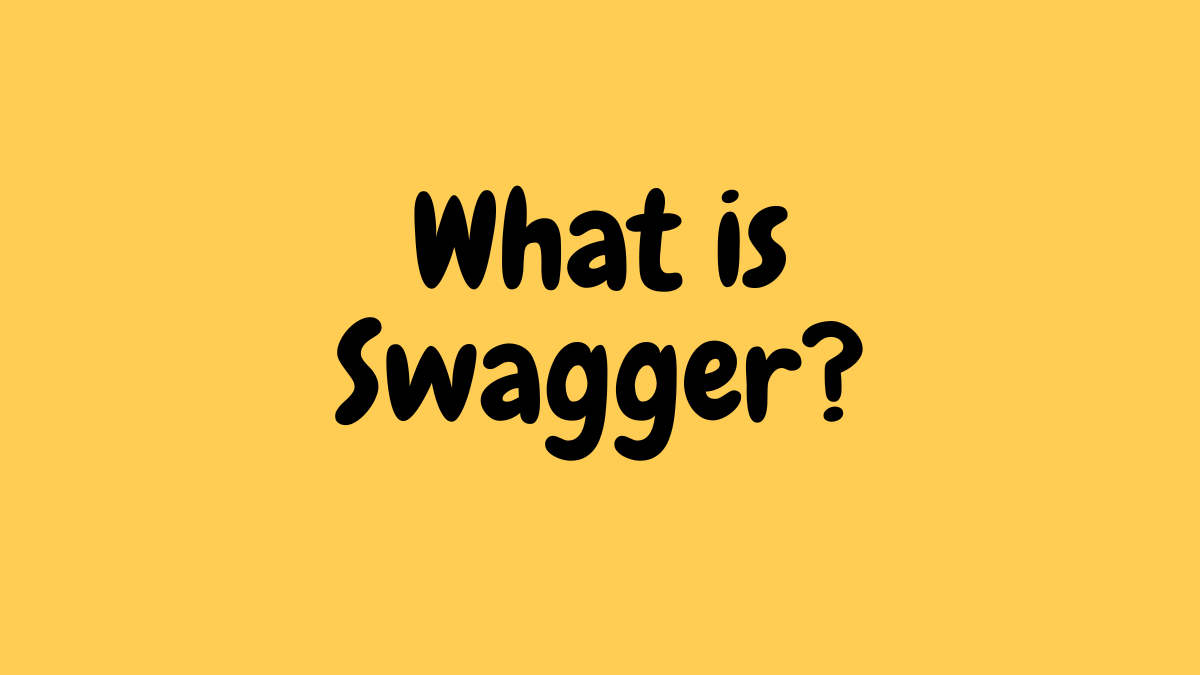What is Swagger?
A concise explanation of Swagger and the OpenAPI ecosystem, tooling, benefits, and best practices.

# What is Swagger? Complete Guide to OpenAPI Specification
Swagger is a comprehensive ecosystem of open-source tools and specifications designed to streamline the entire lifecycle of RESTful APIs. Originally introduced as the "Swagger Specification," it has evolved into what we now know as the OpenAPI Specification (OAS), setting the industry standard for API design and documentation.
When developers mention "Swagger" today, they're typically referring to the powerful tooling ecosystem that surrounds the OpenAPI specification — including Swagger UI, Swagger Editor, and various code generators that accelerate API development.
# Why Swagger and OpenAPI Matter
APIs serve as contracts between different services and their consumers. Without clear, machine-readable contracts, integration becomes a nightmare of miscommunication, bugs, and development delays.
The Swagger/OpenAPI ecosystem addresses these challenges by providing:
- • Machine-readable specifications that describe endpoints, parameters, request/response schemas, and authentication methods
- • Automated tooling for generating interactive documentation, client SDKs, server stubs, and comprehensive tests
- • Unified communication between frontend teams, backend developers, QA engineers, and product managers
# The Business Impact
Organizations adopting OpenAPI-first approaches typically see:
- • 50% reduction in API integration time
- • Fewer production bugs due to contract validation
- • Faster developer onboarding with interactive documentation
- • Improved collaboration across development teams
# A Brief History of Swagger
Understanding Swagger's evolution helps explain why it's become the de facto standard for API documentation:
- • 2010: Tony Tam creates Swagger as an open-source specification and toolset
- • 2015: Swagger specification donated to the Linux Foundation
- • 2016: OpenAPI Initiative formed, specification renamed to "OpenAPI"
- • 2017: OpenAPI 3.0 released with major improvements
- • 2021: OpenAPI 3.1 aligned with JSON Schema specification
Today's ecosystem uses "Swagger" for the tooling (maintained by SmartBear) while "OpenAPI" refers to the formal specification standard.
# Core Components of the Swagger Ecosystem
# OpenAPI Specification (OAS)
The foundation layer — a standardized format (YAML or JSON) that describes your API's structure, endpoints, and behavior patterns.
# Swagger UI
Transforms OpenAPI descriptions into beautiful, interactive documentation that allows users to explore endpoints and test requests directly in their browser.
# Swagger Editor
A powerful web-based editor for authoring OpenAPI documents with real-time validation, syntax highlighting, and live preview capabilities.
# OpenAPI Generator
Generates production-ready client SDKs and server stubs in 40+ programming languages from your OpenAPI specification.
# SwaggerHub (Commercial)
Enterprise-grade collaboration platform for API design, documentation, and team coordination throughout the API lifecycle.
# How Swagger/OpenAPI Works
The workflow follows a contract-first approach:
# Define Your API Contract
Create an OpenAPI document describing:
- • Paths and Operations: Available endpoints and HTTP methods
- • Parameters: Path, query, header, and cookie parameters
- • Request/Response Bodies: Detailed schemas with validation rules
- • Authentication: Security schemes and authorization flows
- • Metadata: API information, versioning, and contact details
# Generate and Validate
Tools consume your specification to:
- • Render interactive documentation
- • Generate client libraries and server code
- • Validate requests/responses against schemas
- • Create automated tests and mock servers
# Key Benefits of Adopting Swagger/OpenAPI
# Documentation That Stays Current
Your specification serves as the single source of truth, automatically staying synchronized with your actual API implementation.
# Accelerated Developer Onboarding
New team members and external integrators can quickly understand and start using your APIs through interactive documentation.
# Reduced Integration Errors
Auto-generated client SDKs eliminate manual coding mistakes and ensure consistent API consumption patterns.
# Enhanced Testing Capabilities
Schema validation in CI/CD pipelines catches breaking changes before they reach production environments.
# Parallel Development
Mock servers enable frontend teams to develop against API contracts before backend implementation is complete.
# When to Use Swagger/OpenAPI
Swagger/OpenAPI excels in specific scenarios where the investment pays significant dividends.
# Ideal Scenarios
- • Public APIs requiring comprehensive documentation and SDK support
- • Microservices architectures needing formal service contracts
- • Large development teams benefiting from automated code generation
- • API-driven organizations focused on reducing integration friction
- • Projects with strict compliance requirements for documentation
# Consider Alternatives When
- • Building simple, internal-only APIs with minimal consumers
- • Working with non-REST architectures (GraphQL, gRPC)
- • Dealing with highly dynamic APIs that change frequently
# Best Practices for Success
# Design-First Approach
Start with your OpenAPI specification before writing implementation code. This contract-first methodology prevents API design debt.
# Modular Schema Design
Create reusable components and schemas to maintain consistency across your API and reduce duplication.
# Rich Examples and Descriptions
Include comprehensive examples in request/response bodies and detailed descriptions for all parameters.
# Version Management
Explicitly version your APIs and reflect versioning strategies in your OpenAPI documents.
# Automated Validation
Integrate schema validation into development workflows and CI/CD pipelines to catch issues early.
# Security Documentation
Clearly document authentication schemes, authorization flows, and security requirements.
# Common Misconceptions Debunked
Let's address some widespread misunderstandings about Swagger and OpenAPI.
# "Swagger is just documentation"
Reality: OpenAPI specifications serve as executable contracts that power tooling throughout the entire development lifecycle.
# "Code generation creates production-ready clients"
Reality: Generated code provides excellent starting points but typically requires customization, testing, and review for production use.
# "You must hand-write specifications"
Reality: Multiple approaches work — hand-writing, code annotation generation, or visual editing tools. Choose what fits your team's workflow.
# Getting Started: Quick Implementation Guide
# Step-by-Step Process
- • Install the Swagger Editor or use an online editor
- • Draft an OpenAPI YAML describing your key endpoints
- • Use Swagger UI to see interactive documentation
- • Try generating a client or server stub with OpenAPI Generator
- • Integrate schema validation in your tests or runtime